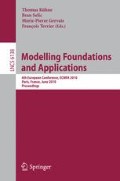Abstract
Use cases are commonly used to structure and document requirements while UML activity diagrams are often used to visualize and formalize use cases, for example to support automated test case generation. Therefore the automated support for the transition from use cases to activity diagrams would provide significant, practical help. Additionally, traceability could be established through automated transformation, which could then be used for instance to relate requirements to design decisions and test cases. In this paper, we propose an approach to automatically generate activity diagrams from use cases while establishing traceability links. Data flow information can also be generated and added to these activity diagrams. Our approach is implemented in a tool, which we used to perform five case studies. The results show that high quality activity diagrams can be generated. Our analysis also shows that our approach outperforms existing academic approaches and commercial tools.
Access this chapter
Tax calculation will be finalised at checkout
Purchases are for personal use only
Preview
Unable to display preview. Download preview PDF.
References
IEEE Std. 830-1998, IEEE Standard for Software Requirement Specification (1998)
Berenbach, B., Inc, S.C.R., Princeton, N.J.: The evaluation of large, complex UML analysis and design models. ICSE (2004)
Bittner, K., Spence, I.: Use Case Modeling. Addison-Wesley, Boston (2002)
Brown, E.K., Miller, J.E.: Syntax: a linguistic introduction to sentence structure. Routledge (1992)
Bruegge, B., Dutoit, A.H.: Object-Oriented Software Engineering Using UML, Patterns, and Java. Prentice-Hall, Englewood Cliffs (2009)
CaseComplete: http://www.casecomplete.com/
Chen, T.Y., Tang, S.F., Poon, P.L., Tse, T.H.: Identification of categories and choices in activity diagrams. In: QSIC 2005, Citeseer, pp. 55-63 (2005)
Eclipse Foundation: Eclipse Modeling Framework
Fliedl, G., Kop, C., Mayr, H.C., Salbrechter, A., Vöhringer, J., Weber, G., Winkler, C.: Deriving static and dynamic concepts from software requirements using sophisticated tagging. Data Knowl. Eng. 61, 433–448 (2007)
Fowler, M.: UML distilled: a brief guide to the standard object modeling language. Addison-Wesley, Reading (2003)
Gomaa, H.: Designing Concurrent, Distributed, and Real-Time Applications with UML. Addison-Wesley, Reading (2000)
Gutiérrez, J.J., Clémentine, N., Escalona, M.J., Mejías, M., Ramos, I.M.: Visualization of Use Cases through Automatically Generated Activity Diagrams. In: Czarnecki, K., Ober, I., Bruel, J.-M., Uhl, A., Völter, M. (eds.) MODELS 2008. LNCS, vol. 5301, pp. 83–96. Springer, Heidelberg (2008)
Ilieva, M.G., Ormandjieva, O.: Models Derived from Automatically Analyzed Textual User Requirements. Soft. Eng. Research, Management and Applications (2006)
Kermeta: Kermeta metaprogramming environment. Triskell team
Kruchten, P.: The Rational Unified Process: An Introduction. Addison-Wesley, Reading (2003)
Mustafiz, S., Kienzle, J., Vangheluwe, H.: Model transformation of dependability-focused requirements models. In: ICSE Workshop on Modeling in Software Engineering (2009)
Nebut, C., Fleurey, F., Le Traon, Y., Jezequel, J.M.: Automatic test generation: A use case driven approach. IEEE TSE 32, 140–155 (2006)
Olsen, G.K., Oldevik, J.: Scenarios of traceability in model to text transformations. ECMDA-FA. Haifa, Israel (2007)
OMG: UML 2.2 Superstructure Specification
RAVENFLOW: http://www.ravenflow.com/
The Stanford Natural Language Processing Group. The Stanford Parser version 1.6
Visual Paradigm for UML: http://www.visual-paradigm.com/product/vpuml/
Waheed, T., Iqbal, M.Z.Z., Malik, Z.I.: Data Flow Analysis of UML Action Semantics for Executable Models. ECMDA-FA (2008)
Yue, T., Briand, L.C., Labiche, Y.: A Use Case Modeling Approach to Facilitate the Transition Towards Analysis Models: Concepts and Empirical Evaluation. In: Schürr, A., Selic, B. (eds.) MODELS 2009. LNCS, vol. 5795, pp. 484–498. Springer, Heidelberg (2009)
Yue, T., Briand, L.C., Labiche, Y.: Automatically Deriving a UML Analysis Model from a Use Case Model. Carleton University (2009)
Yue, T., Briand, L.C., Labiche, Y.: A Systematic Review of Transformation Methodologies between User Requirements and Analysis Models. Carleton University (2009)
Yue, T., Briand, L.C., Labiche, Y.: An Automated Approach to Transform Use Cases into Activity Diagrams. Carleton University, Technical report SCE-10-01 (2010)
Author information
Authors and Affiliations
Editor information
Editors and Affiliations
Rights and permissions
Copyright information
© 2010 Springer-Verlag Berlin Heidelberg
About this paper
Cite this paper
Yue, T., Briand, L.C., Labiche, Y. (2010). An Automated Approach to Transform Use Cases into Activity Diagrams. In: Kühne, T., Selic, B., Gervais, MP., Terrier, F. (eds) Modelling Foundations and Applications. ECMFA 2010. Lecture Notes in Computer Science, vol 6138. Springer, Berlin, Heidelberg. https://doi.org/10.1007/978-3-642-13595-8_26
Download citation
DOI: https://doi.org/10.1007/978-3-642-13595-8_26
Publisher Name: Springer, Berlin, Heidelberg
Print ISBN: 978-3-642-13594-1
Online ISBN: 978-3-642-13595-8
eBook Packages: Computer ScienceComputer Science (R0)

